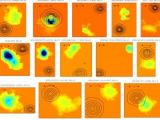As you probably already know, more than 95 percent of the matter in the universe is mostly invisible to the electromagnetic spectrum, meaning it is not emitting any form of light. However, just because an object is invisible, it does not necessarily mean it is not there. Astronomers searching for new distant galaxies and matter across the universe recently received new aid in detecting remote galaxies from the ESO's Very Large Telescopes.
Now, it is well known that quasars can be found in the large majority of the galaxies populating the space, so astronomers thought that, locating distant quasars, they would be able to find galaxies that remained undetected in previous scans of the sky. Doing so, the VLT found about twelve new galaxies lying half-way across the universe.
The method has been previously used by a team of astronomers led by Nicola Bouch?. Quasars are essentially massive black holes in the process of 'feeding'. Thus, accreting large amounts of matter, they emit huge amounts of light and radiation, sometimes even surpassing the brilliance of a galaxy with a factor of one thousand or more. Revealing the light beacons emitted by such objects and studying the light spectrum resulted during the light absorption through the gas clouds contained in the galactic disk, astronomers were able to search for galaxies in the state they were when the universe was only 6 billion years old.
Most of the time, these galaxies are rendered invisible by the huge contrast between the light the quasar emits and that of the galaxy. However, the VLT's SINFONI instrument, consisting of an infrared 'integral field spectrometer', is able to reveal high resolution clear images of the structures lying in the respective area of space. This means that SINFONI can differentiate between the light emitted by the quasar and that of the galaxy.
The method has proven a huge success so far, with a massive 70 percent detection rate which resulted in the discovery of 14 new galaxies out of a sample of about 20 quasars located in different areas of the sky.
Bouch? argues that such galaxies present special interest due to their unique features. Unlike most of the old galaxies observed in the close vicinity of ours, these ones are extremely active, forming large numbers of stars. A quick evaluation revealed that these structures, dubbed 'starburst galaxies', have a rate of about 20 new stars per year. Furthermore, due to SINFONI's detailed images, accurate measurements can be made inside the galaxy, such as the internal motions of the different objects.

 14 DAY TRIAL //
14 DAY TRIAL // 
